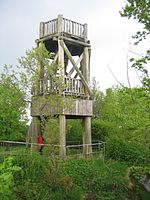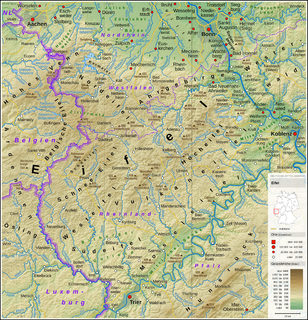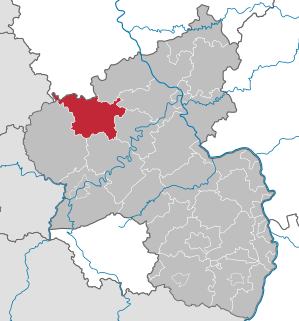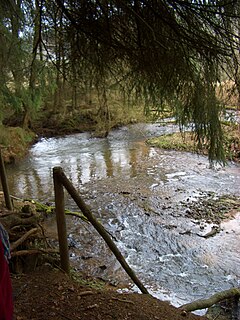| Dietzenley | |
|---|---|
Viewing tower on the Dietzenley | |
| Highest point | |
| Elevation | 617.6 m above sea level (NHN) (2,026 ft) [1] |
| Coordinates | 50°12′09″N6°40′40″E / 50.2025°N 6.67778°E Coordinates: 50°12′09″N6°40′40″E / 50.2025°N 6.67778°E |
| Geography | |
| Parent range | Volcanic Eifel |
| Geology | |
| Mountain type | volcano |
| Type of rock | Basalt |
The Dietzenley in the county of Vulkaneifel in the German state of Rhineland-Palatinate is a mountain, 617.6 m above sea level (NHN) , [1] and the highest point in the Pelm Forest, a part of the Volcanic Eifel range.

Rhineland-Palatinate is a state of Germany.
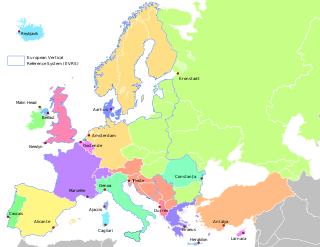
Normalhöhennull or NHN is a vertical datum used in Germany.

Pelm is an Ortsgemeinde – a municipality belonging to a Verbandsgemeinde, a kind of collective municipality – in the Vulkaneifel district in Rhineland-Palatinate, Germany. It belongs to the Verbandsgemeinde of Gerolstein, whose seat is in the like-named town.
The Dietzenley rises within the Volcanic Eifel Nature Park in the parish of Gerolstein north and above the Gerolstein quarter of Büscheich-Niedereich.

The Volcanic Eifel Nature Park lies in the counties of Bernkastel-Wittlich, Cochem-Zell and Vulkaneifel in the German state of Rhineland-Palatinate. The nature park, which is in the Eifel mountains, and which is also a geopark, was inaugurated on 31 May 2010 and has an area of 1,068.24 km².> Its sponsor is the Natur- und Geopark Vulkaneifel GmbH.

Gerolstein is a town in the Vulkaneifel district of Rhineland-Palatinate, Germany. Gerolstein is a local municipality of the Verbandsgemeinde Gerolstein. It has been approved as a Luftkurort.
On the largely wooded domed summit stands a small, wooden observation tower, which offers a good view of the Volcanic Eifel. Somewhat below it there is an electrical converter and the remains of a Celtic ringwall.
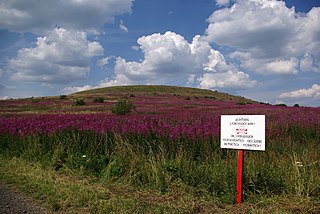
A Kuppe is the term used in German-speaking central Europe for a mountain or hill with a rounded summit that has no rock formation, such as a tor, on it. A range of such hills is called a Kuppengebirge. In geology the term also refers to corresponding stratigraphic forms. The term is similar to the English topographical and geological terms, knoll and dome. It is similar to the French word ballon which means a mountain with a rounded summit.

An observation tower is a structure used to view events from a long distance and to create a full 360 degree range of vision to conduct the long distance observations. They are usually at least 20 metres (66 ft) tall and made from stone, iron, and wood. Many modern towers are also used as TV towers, restaurants, or churches. The towers first appeared in Germany at the end of the 18th century, and their numbers steadily increased, especially after the invention of the lift.

The Celts are an Indo-European ethnolinguistic group of Europe identified by their use of Celtic languages and cultural similarities. The history of pre-Celtic Europe and the exact relationship between ethnic, linguistic and cultural factors in the Celtic world remains uncertain and controversial. The exact geographic spread of the ancient Celts is disputed; in particular, the ways in which the Iron Age inhabitants of Great Britain and Ireland should be regarded as Celts have become a subject of controversy. According to one theory, the common root of the Celtic languages, the Proto-Celtic language, arose in the Late Bronze Age Urnfield culture of Central Europe, which flourished from around 1200 BC.
The Dietzenley may be reached on footpaths from Gerolstein, Pelm or Gees.

